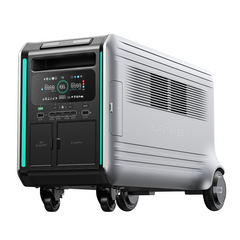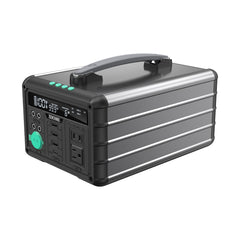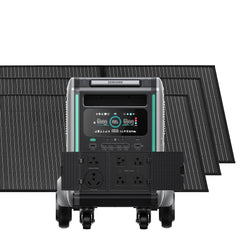Powering Your Home: A Guide to Home Battery Backup Systems
A battery backup system is a way to provide electricity in the event of a power outage. They typically use lead-acid, nickel-cadmium, nickel-metal hydride, or lithium-ion batteries to store power used at night during an outage. Battery backup systems are popular for their reliability and convenience, and the devices are often easy to install, but they sometimes have a high upfront cost.
How Home Battery Backup Systems Work
Home battery systems store energy provided by the utility company or a homeowner's electric supply, as well as any excess solar or wind power generated during the day. When electricity is needed in the evening, batteries are charged to provide power. In some systems, a timer controls when the system begins and stops charging batteries. When too much power is stored in the batteries, they are discharged to prevent overheating and damage.

Components of a home battery backup system
1. Battery
Home battery systems store energy provided by the utility company or a homeowner's electric supply, as well as any excess solar or wind power generated during the day. When electricity is needed in the evening, batteries are charged to provide power. In some systems, a timer controls when the system begins and stops charging batteries. When too much power is stored in the batteries, they are discharged to prevent overheating and damage. It is also possible for homeowners to control their home battery system manually.
2. Inverter
Inverters take the direct current from the batteries and turn it into alternating current, which is used to power lights and appliances in a home. It also allows two or more batteries to be used in a battery backup system.
3. Charge controller
It is the heart of the system. The charge controller ensures that batteries are not overcharged, which can cause them to overheat. It regulates the current from the inverter and battery charger so that batteries do not become overcharged or suffer from deep discharges, which can damage or destroy them. It also prevents batteries from being overcharged when they are receiving stored energy.
4. Monitoring system
The monitoring system is sometimes compared to a thermostat. This device is the primary device allowing homeowners to control their battery backup system manually. It includes a circuit that monitors the amount of power drawn from the batteries and what it does with them. It will turn off the inverter when too much energy is drawn from the batteries, which can cause them to overheat. It will also beep or send an email to alert a homeowner that the system is turning off. If homeowners want to intervene, they can adjust the circuit settings or purchase a home automation product such as a scene controller.
5. Transfer switch
This device helps the battery backup system power a home when a power outage occurs. When the utility company provides power during normal operation, it will be used first. However, if an outage occurs, the transfer switch will automatically route power from the utility grid to devices in a home and from there to devices powered by batteries. It can allow normal operations for refrigerators and sump pumps to continue working. It also allows for battery backup systems to provide power to lights.
6. Backup generator
It is a gas-powered generator that can power your home during an outage. While it is not a necessary part of any backup power station system, it is a nice addition for those who want to ensure they will have power during an outage. These generators are often installed in the garage or other location on the same property so that homeowners can easily reach them.
Different types of home battery backup systems
1. Lead-Acid Batteries
They are the most common type of battery used in battery backup systems. They are generally the best option for homeowners with the longest performance life and the highest power level. They also have a very low self-discharge rate, but they chip, swell, and lose capacity over time. It is important to ensure that they are maintained and checked frequently. They are also the most expensive type of battery, but they should last the longest if properly cared for.
2. Lithium-Ion Batteries
They are the newest type of battery and may have the highest energy density. However, they also have a relatively low storage capacity, so they are often paired with other batteries for battery backup systems. They have the lowest self-discharge rate of any battery and can be installed outside if necessary.
3. Flow Batteries
Flow batteries are a mixture of different types of batteries. They are often made up of several different types of batteries, including lead-acid batteries, lithium-ion, and nickel-iron flow batteries. With these types of batteries, a fully charged battery can be discharged completely within 24 hours. As such, they are often paired with other batteries to provide the most power possible.
4. Sodium-Ion Batteries
These are the most common type of batteries for electric vehicles. They can be very powerful but also have a low capacity, so they are often paired with other batteries to provide sufficient power. It is also important to note that it is necessary to have a battery charger with a converter to charge them.
5. Semi-Solid State Batteries
These batteries are similar to the lithium-ion batteries used in cell phones. They have a higher energy density than they would without supporting grids and have a long run time. They can be paired with other batteries but have a relatively low storage capacity. As such, it is necessary to pair them with other batteries for best results and redundancy, especially when used in larger battery backup systems.
Advantages of Home Battery Backup Systems
1. Power Resilience
A battery backup system can provide power for a home even if the utility grid goes down. It can allow for some items in a home to be kept working even during an outage. It also allows important safety items like smoke detectors and medical equipment to continue functioning. It can also affect electrical appliances so that a circuit breaker or knob can not shut off.
2. Energy Independence
Many people with solar panels installed on their roofs may be surprised to learn that they are not producing the energy they believe they are. It is because the sun provides most of the power to their homes. It is also true that batteries can store energy, but not to the extent required for many types of homes. As such, a battery backup system can provide energy during cloudy days and other times when it would otherwise be unavailable.
3. Cost Savings
An energy audit can help a homeowner discover where their current energy use is high. Once this is discovered, the homeowner can make changes to reduce the power being used. Installing a battery backup system with smart thermostats and other home automation equipment can also help reduce costs by making it easier to lower the settings on air conditioners and other power-hungry devices.
4. Environmental Benefits
Many people today are interested in their carbon footprint. Some have solar panels installed on their roofs, but this only provides a certain amount of power to a home. Battery backups allow homeowners to be completely off the grid and not use any energy from the utility company. It can be great for those who want to reduce their carbon footprint or want to rely less on non-renewable sources of energy.
5. Increased Home Value
Many homeowners use solar panels on their roofs and invest in other green sustainability technologies. It makes them more environmentally friendly, which can contribute to higher home value. Depending on the model, these systems often come with performance-based warranties for up to 15 years. It affects the homeowner's ability to sell their home, as well as their ability to be a good environmental citizen.
Disadvantages of Home Battery Backup Systems
1. High Upfront Costs
The biggest disadvantage of a battery backup system is the price. It is due to the high price of quality batteries and the installation and maintenance costs associated with installing a large battery backup system. It can often make it very expensive for many homeowners and may not be feasible for others. Working with an experienced team that can help determine the best system for your specific needs is important.
2. Limited Capacity
Batteries are very powerful, but they are also very expensive. As a result, it is often necessary to pair them with other batteries to provide sufficient power. It makes the cost even higher and can make it extremely difficult for many homeowners to justify installing a battery backup system. It is also important to consider that most people don't have the storage space in their homes to do this.
3. Maintenance Requirements
These systems require more maintenance than other types of backup systems. It is because batteries are full of volatile chemicals and can get hot, which can cause fires. It can make it necessary for a professional to inspect and maintain these systems regularly. It is also necessary for homeowners to closely monitor the status of the batteries and not allow them to become overcharged or deeply discharged.
4. Limited Lifespan
Not only do these systems have a high cost, but they also have a limited lifespan. It is because they are made up of many small parts that can wear out or corrode over time. Many homeowners report that their batteries must be changed after about five years. It can also take days or weeks to charge them completely. It means they can not always be used as a backup energy source when needed most.
Factors to consider when choosing the Right Home Battery Backup System
1. Power Needs
The physical size of the home and the number of occupants should be considered. It will help determine how large the system should be, which can then be used to determine what type of battery backup system is best. It is also important to keep in mind the insulation in the home. It can result in power fluctuations if it is not adequate for the amount of power being used. It can make deciding on a battery backup system more difficult since too large a system may not fit well into a home.
2. Budget
Homeowners should consider how much they are willing to spend and what level of quality they want. Many batteries, tools, and other materials will all add to the cost. It includes the taxes on all these items and the installation cost. Classes can also be purchased to help homeowners with their system selection and post-installation maintenance. It can help homeowners make better decisions later on when comparing systems with similar features but different prices.
3. Home Size
The size of the home will directly affect how a battery backup system operates. Smaller homes with less insulation may need to be paired with other batteries, but this can increase the cost. In climates that are colder or warmer than most, it is necessary to have certain types of batteries installed. It can also affect the size and cost of a battery backup system. It is important to understand the different types of batteries used in these systems so that you can make a more informed decision about what is right for your home.
4. Battery Type
It is important to understand how the different batteries in the system will impact your home's power needs. Some batteries have higher and lower energy peaks, while others are designed to maintain their charge throughout the day. The types of systems used in homes also vary by country, so the type of battery that works best for your home may differ from those used in homes in other countries. A professional with experience with various battery backup methods should be consulted before selecting a system.
5. Backup Time
The battery backup system's time to fully charge can be a big factor to consider. If you live in a climate with harsh winters, it may be necessary to have a system that can restore power quickly or maintain a charge throughout the day. All of these factors should be considered so that you can make well-informed decisions when it comes time to select and install a battery backup system.
6. Installation and Maintenance Requirements
The installation and maintenance requirements are very important to consider when choosing a battery backup system. A professional must install some of these systems, while others come pre-assembled. The installation cost can vary quite a bit between different types of systems. The cost of testing and maintaining the battery can also affect your final decision since you must pay for this service every few months or years.
Recommended Home Battery Backup Product
1. Versatility
Zendure SuperBase V Solar Generators is a very versatile backup generator. It comes with one suitcase that is used to charge the battery itself, while the other suitcase is used to charge the laptop and other small devices. It can be used in indoor and outdoor settings, making it easy to take on camping trips or use in case of a power outage. This product is compatible with many laptops, phones, and tablet computers.
2. High Capacity
It is important to have a backup generator that has a high capacity. It will allow you to run several appliances simultaneously and keep your power needs as low as possible. Determining the battery size needed in a backup generator is important to purchase the largest one that works for your needs. While larger batteries are more expensive, they can provide more power. The Zendure SuperBase V Solar Generators have a capacity of 5KW with a battery size of 5,000Wh. It is also compatible with many devices, including laptops, computers, and tablets.
3. Portable
Many people want to use their backup generator in outdoor settings with a risk of theft or damage. It can be made much easier with a portable generator. The Zendure SuperBase V Solar Generators come with suitcases that can be used separately and together if needed. It is also very light since it only weighs up to 15-20Kg, making it easy to transport while staying out in the elements.
4. Durability
Since backup generators are used in areas with a high risk for theft, it is important to have one that is durable and can withstand high-impact situations. The Zendure SuperBase V Solar Generators have an IP54 rating, which means it is impenetrable against dust and water. It can work inside or outside without damaging the generator or devices. It also has a metal grill over the openings, making it virtually impossible for dust or water to get inside. It helps ensure that the generator will last for many years to come and be able to provide power when needed, no matter what type of situation you are in.
5. Safety Features
Since backyard generators are most often used to power critical equipment and devices, it is important to ensure they are safe. The Zendure SuperBase V Solar Generators have high voltage protection. It means that if the voltage being supplied is too high, it will not be able to provide a charge until the problem is fixed. It helps protect both the generator and your equipment from damage that can occur due to improper voltage levels. It also has an intelligent charging system that can determine when the battery needs charging or discharging based on its current charge level.
6. Quiet and Eco-Friendly
Since backup generators are used in outdoor settings, it is important to ensure they are as eco-friendly as possible and not very noisy. The Zendure SuperBase V Solar Generator is quiet even with 4 engines running, making it suitable for use while camping or watching television. It only produces noise of up to 82Db, much lower than the typical generator noise level of 100Db. The sound this generator produces helps create a cooling effect on the engine.













